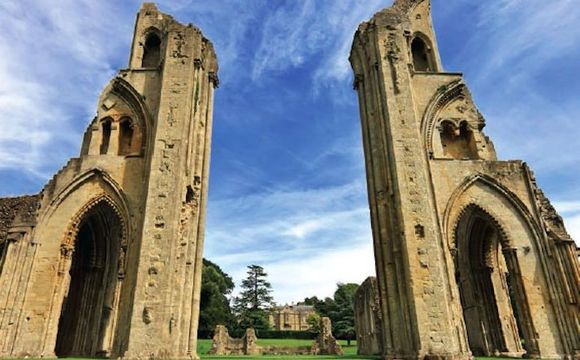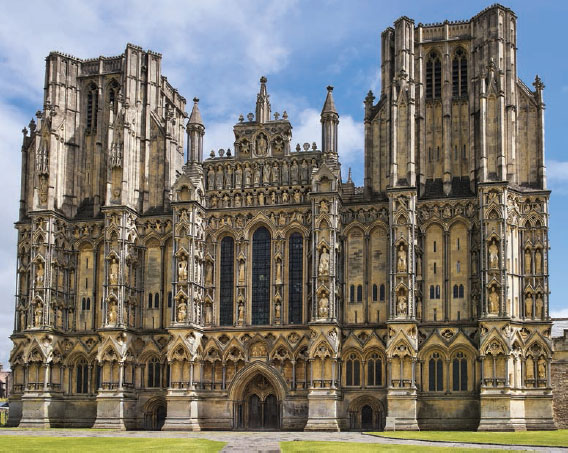
Glastonbury Abbey.
A five-day drive from London to Wells will take you on a picturesque road trip with a wonderful destination.
Miles from the motorway, dual carriageways and train lines, the tiny Somerset cathedral city of Wells (population 11,000) may be all the more rewarding for its out-of-the-way location. It is actually the smallest city in England, because of historic Wells Cathedral, widely regarded as one of the most beautiful in the country.
With a bustling market square, cobbled streets and plenty of medieval architecture, Wells makes a perfect destination for a road trip with a stay of several days in a single place.
DAY 1: GETTING TO WELLS
From a start at London Heathrow or the M25, Wells is a comfortable day's drive allowing for stops along the way. Most directly, it might be the M4 west, and then head south from Bath about 20 miles on the A39. From the A4 south of Swindon, take the A361 through Devises, Westbury, and Frome. That's a rural drive of several hours, but there is much to see of interest, including Avebury Stone Circle.

Wells Cathedral's famous West Front is a gallery of some 300 sculptured saints, patriarchs and princes - DVH PHOTOGRAPHY
The White Hart Hotel, The Swan Hotel (Best Western) and The Crown at Wells are all city center hotels of historic style and character, and all within steps of the cathedral close. For other accommodation options in and around the town center, as well as an introduction to the area's history and sights visit wellssomerset.com.
Two dozen choices for food and drink surround the Market Place and along the High Street. Spend an evening at the City Arms, once the old city jail and now a great gastropub.
DAY 2: WONDERS OF WELLS
A FINE PLACE to start is always the tourist information center. Wells' visitors' center is centrally located on Cathedral Green, sharing a building with the city's local history museum. The commanding visit, however, is dramatic Wells Cathedral. Architecturally unique and the oldest Gothic cathedral in England, Wells has several claims to fame, including its unique West Front which is a virtual gallery of medieval sculpture as well as unrivaled medieval stained glass and the second oldest clock in Britain. Its acclaimed cathedral choir can be heard daily at 5:15 p.m. in choral evensong.
Adjacent to the cathedral, the medieval Bishop's Palace is moated, its water springing from the wells that gave the city its name. Visit the ruined Great Hall, splendid chapel and acres of delightful gardens. On the other side of the cathedral wander down the 14th-century Vicars' Close, considered the most complete medieval street in the country. Just outside the Cathedral Close, Wells' pretty Market Place bustles with an open-air market Wednesdays and Saturdays.
DAY 3: CHEESE AND CAVES IN CHEDDAR GORGE
TAKE A RIDE THIS MORNING across the ridge of the Mendip Hills to the west. The most dramatic route is the B3135, which goes over the top and down through Cheddar Gorge, sometimes called the Grand Canyon of Britain. It's not quite that spectacular, but still pretty impressive. At the lower end, the canyon is laced with an extensive network of lime-stone caves. Become a spelunker with a visit to Gough's Cave or Cox's Cave.
In the village of Cheddar, don't miss the Cheddar Gorge Cheese Company, where the famous eponymous cheese is still made. Watch the process from the viewing gallery and sample the results at the free taster bar. Then, very energetic folks can climb the 274 stairs of Jacob's Ladder and follow the three-mile circuit of the Clifftop Gorge Walk. It is an easy return to Wells via the A371. On the way, you might visit Somerset's most famous caves at Wookey Hole. It is an unabashed touristy attraction, but no less impressive for that.
DAY 4: LEGENDS OF GLASTONBURY AND THE SOMERSET LEVELS
TODAY'S EXCURSION leads a dozen miles south on the A39 to Glastonbury. Certainly one of the earliest Christian sites in England, by legend it claims association with Jesus even before Christianity. It is here (referenced in the hymn “Jerusalem,” with lyrics by poet William Blake) that Jesus was supposedly brought as a boy by his uncle, Joseph of Aramathea. That legend gave rise to Glastonbury's ancient Arthurian connections. Said Joseph is reputed to have returned to Glastonbury and here deposited the Holy Grail in what for centuries has been known as Chalice Well.
The evocative visit is to Glastonbury Abbey, originally raised by the Saxons in the 7th century. Expanded over the centuries, Glastonbury was a wealthy and important Christian foundation until the 1539 Dissolution by King Henry VIII. See its storied history at its superb museum. The manicured grounds also contain the famed Glastonbury Thorn and the site where the graves of King Arthur and Guinevere were supposedly discovered by monks (most certainly a spurious claim). On the town's outskirts, climb Glastonbury Tor, itself replete with legends and offering unbroken views over the Somerset Levels to the south and Mendip Hills to the north.
DAY 5: ALWAYS SPOILED FOR CHOICE
ACROSS THE LEVELS to the west, the Battle of Sedgemoor, July 9, 1685, was fought in Westonzoyland, a few miles east of Bridge-water. Among the last battles on English soil, it disastrously ended the ill-fated Duke of Monmouth's rebellion against the Catholic King James II. Visit the battle site and its memorial just off the A372. Among the results, then Colonel John Churchill was promoted to Major General and, of course, went on to become one of the great military leaders in history—as well as the 1st Duke of Marlborough. You might route by the villages of Rodney Stoke or Shapwick, two of the few British “Thankful Villages” that lost no men in World War I. Their thankfulness is remembered in the village churches.
Half an hour's drive or so to the east (via Wincanton), the incomparable National Trust landscape gardens of Stourhead are an unforgettable visit any season of the year. It is well worth the stroll around the lake.
CONTINUING THE JOURNEY
When the time comes to move on, Bath, Bristol, and South Wales all lay a short drive to the north. South on the A37, an hour or so leads to Sherborne with its famous abbey and castles.
Here you enter Thomas Hardy Country, but that's another road trip.
* Originally published in Feb 2018.





Comments